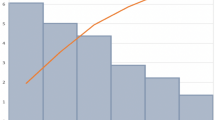Abstract
To improve the fermentation yield of xylanase by optimizing the fermentation conditions for strain Xw2, a Plackett-Burman design was used to evaluate the effects of eight variables on xylanase production by strain Xw2. The steepest ascent (descent) method was used to approach the optimal response surface experimental area. The optimal fermentation conditions were obtained by central composite design and response surface analysis. The results showed that the composition of the optimal fermentation medium was corn cob + 1.5% wheat bran (1:1), 0.04% MnSO4, 0.04% K2HPO4·3H2O, and an inoculum size of 6% in 50 mL liquid volume (pH = 6.0). The optimal culture conditions were 28°C at 150 r/min for 54.23 h. The results of this study can serve as the basis for the industrial production and application of xylanase.
Similar content being viewed by others
References
Bastawde K B (1992). Xylan structure, microbial xylanases, and their mode of action. World J Microb Biot, 8(4): 353–368
Coughlan M P, Hazlewood G P (1993). beta-1,4-D-xylan-degrading enzyme systems: biochemistry, molecular biology and applications. Biotechnol Appl Biochem, 17(Pt 3): 259–289
Ding C H, Jiang Z Q, Li X T, Li L T, Kusakabe I (2004). High activity xylanase production by Streptomyces olivaceoviridis E-86. World J Microb Biot, 20(1): 7–10
Francis F, Sabu A, Nampoothiri K M, Ramachandran S, Ghosh S, Szakacs G, Pandey A (2003). Use of response surface methodology for optimizing process parameters for the production of [alpha]-amylase by Aspergillus oryzae. Biochem Eng J, 15(2): 107–115
Li Y, Cui F, Liu Z, Xu Y, Zhao H (2007a). Improvement of xylanase production by Penicillium oxalicum ZH-30 using response surface methodology. Enzyme Microb Tech, 40(5): 1381–1388
Li Y, Liu Z, Cui F, Liu Z, Zhao H (2007b). Application of Plackett-Burman experimental design and Doehlert design to evaluate nutritional requirements for xylanase production by Alternaria mali ND-16. Appl Microbiol Biotechnol, 77(2): 285–291
Panbangred W, Shinmyo A, Kinoshita S, Okada H (1983). Purification and properties of endoxylanase produced by Bacillus pumilus. Agric Biol Chem, 47(5): 957–963
Polizeli M L T M, Rizzatti A C S, Monti R, Terenzi H F, Jorge J A, Amorim D S (2005). Xylanases from fungi: properties and industrial applications. Appl Microbiol Biotechnol, 67(5): 577–591
Rezende M I, Barbosa A M, Vasconcelos A F D, Endo A S (2002). Xylanase production by Trichoderma harzianum rifai by solid state fermentation on sugarcane bagasse. Braz J Microbiol, 33(1): 67–72
Selinheimo E, Kruus K, Buchert J, Hopia A, Autio K (2006). Effects of laccase, xylanase and their combination on the rheological properties of wheat doughs. Cereal Sci, 43(2): 152–159
Silversides F G, Scott T A, Korver D R, Afsharmanesh M, Hruby M (2006). A study on the interaction of xylanase and phytase enzymes in wheat-based diets fed to commercial white and brown egg laying hens. Poult Sci, 85(2): 297–305
Subramaniyan S, Prema P (2002). Biotechnology of microbial xylanases: enzymology, molecular biology, and application. Crit Rev Biotechnol, 22(1): 33–64
Tanyildizi M S, Ozer D, Elibol M (2005). Optimization of amylase production by Bacillus sp. using response surface methodology. Process Biochem, 40(7): 2291–2296
Uysal H, Bilgicli N, Elgun A, Lbanoglu S, Herken E N, Demir M K (2007). Effect of dietary fibre and xylanase enzyme addition on the selected properties of wire-cut cookies. J Food Engin, 78(3): 1074–1078
Wong K K, Tan L U, Saddler J N (1988). Multiplicity of beta-1,4-xylanase in microorganisms: functions and applications. Microbiol Rev, 52(3): 305–317
Yue Q, Qian Z, Zhiyuan H, et al (2011). Xylanase producing strains, identification and zymography. Qingdao University (Natural Science Edition), 29(2): 54–57
Author information
Authors and Affiliations
Corresponding author
Rights and permissions
About this article
Cite this article
Ye, B., Xue, T., Ye, S. et al. Optimization of fermentation medium for xylanase-producing strain Xw2. Front. Biol. 8, 611–617 (2013). https://doi.org/10.1007/s11515-013-0282-2
Received:
Accepted:
Published:
Issue Date:
DOI: https://doi.org/10.1007/s11515-013-0282-2




